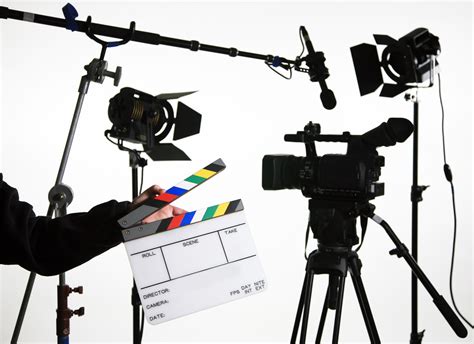Lights, Camera, Action: A Journey into the Field of Film Directing
Are you passionate about the art of storytelling through film? Do you have a keen eye for visual details and a natural knack for leadership? If so, a career in film directing may be the perfect path for you. In this blog post, we will take a deep dive into the world of film directing, exploring the various aspects of this exciting and dynamic field. From understanding the role of a film director to mastering the skills and qualities needed for success, we will uncover the essential elements of film directing. Join us as we explore the film directing process from pre-production to post-production, and learn how directors leave their unique mark on every film they bring to life. Whether you’re a budding filmmaker or simply a film enthusiast, this journey into the world of film directing is sure to inspire and inform.
Table of Contents
The Role of a Film Director
Film directors play a crucial role in the filmmaking process, as they are responsible for bringing a script to life on the screen. They are the visionaries behind the film, overseeing every aspect of the production from pre-production to post-production. A director is not only in charge of the creative decisions, but also the technical and logistical aspects of the film.
One of the key responsibilities of a film director is to collaborate with the screenwriter and bring their vision to fruition. They must have a deep understanding of the script and be able to translate it into a visual narrative that resonates with the audience. In addition to this, directors also work closely with the cinematographer to determine the visual style of the film, as well as the production designer to create the overall aesthetic of the film.
Another important role of a film director is to manage and lead the entire cast and crew. They must be able to communicate their vision clearly and effectively, while also creating a collaborative and harmonious work environment. A director’s leadership skills are essential in ensuring that everyone is working towards the same goal and that the production runs smoothly.
Ultimately, the role of a film director is to transform a script into a compelling and visually stunning film that captivates audiences. They must possess a unique blend of creative vision, leadership skills, and a deep understanding of the filmmaking process in order to bring their vision to life on the big screen.
Skills and Qualities Needed for Film Directing
Film directing is a complex and demanding job that requires a wide range of skills and qualities in order to be successful. Creativity is perhaps the most important skill for a film director, as they are responsible for bringing a script to life and creating a visually engaging and emotionally impactful film. Additionally, communication is crucial for a film director, as they need to be able to effectively convey their vision to the cast and crew, and collaborate with other creative professionals.
Leadership is another essential quality for a film director, as they must be able to inspire and motivate their team to achieve their best work. Moreover, problem-solving skills are also crucial for a film director, as they will inevitably encounter challenges and obstacles throughout the filmmaking process that require quick and effective solutions. In conclusion, film directing requires a combination of technical skill, creative vision, and strong leadership and communication abilities in order to bring a director’s vision to life on the big screen.
Understanding the Film Directing Process
Film directing is a complex and multi-faceted process that involves numerous stages and requires a diverse set of skills and qualities. Film directing is the art of bringing a script to life through the use of visual and auditory storytelling techniques, and it is the director’s vision that ultimately shapes the final product.
One of the key aspects of understanding the film directing process is the pre-production stage. This involves meticulous planning, script analysis, storyboarding, and creating a vision for the film. The director must have a clear understanding of the script and a strong vision for how they want to bring it to life on screen.
Another important part of the film directing process is collaboration. Directors must be able to work closely with the cast and crew, communicate their vision effectively, and inspire others to bring their best to the project. This requires strong leadership and interpersonal skills.
Additionally, the post-production phase is a critical part of the film directing process. This involves overseeing the editing, sound design, and visual effects to ensure that the final product matches the director’s vision. It’s important for directors to be able to make creative decisions and work closely with the post-production team to achieve the desired outcome.
Pre-production: Planning Your Film
Pre-production is a crucial phase in the filmmaking process, as it sets the foundation for the entire project. This is where the director starts to bring their vision to life by meticulously planning every aspect of the film. From scouting locations to creating storyboards, the pre-production stage is all about laying the groundwork for a successful shoot.
One of the key skills needed for effective pre-production planning is organization. A film director must be able to juggle multiple tasks, such as finding the right crew members, coordinating with the production team, and overseeing the budget. Attention to detail is also essential, as even the smallest oversight during this phase can have repercussions throughout the rest of the production.
Another important aspect of pre-production is communication. The director needs to be able to effectively convey their vision to the entire team, from the cinematographer to the production designer. Clear and open communication ensures that everyone is on the same page and working towards a common goal.
Ultimately, pre-production is about setting the stage for a successful film shoot. By carefully planning every aspect of the project, the director can ensure that they have everything they need to bring their vision to life on the screen.
Casting and Working with Actors
When it comes to casting and working with actors, a film director plays a crucial role in finding the right talent to bring their vision to life. The process of casting involves identifying actors who not only fit the physical attributes of the characters but also possess the skills and qualities needed to portray them convincingly.
Once the casting is complete, the director must work closely with the actors to bring out their best performances. This involves open communication, trust-building, and creating a comfortable environment for the actors to explore their characters.
Furthermore, the director must be able to provide constructive feedback, guidance, and support to the actors throughout the filming process. This requires leadership and collaboration skills to ensure that the actors are aligned with the director’s vision for the film.
Ultimately, casting and working with actors is a delicate balance of finding the right talent and nurturing their performances to create a cohesive and compelling on-screen storytelling experience.
Visual Storytelling Techniques
Visual storytelling is a powerful tool for filmmakers to convey their message and connect with their audience. It involves the use of visual elements such as composition, color, and movement to create a compelling and immersive story. One important technique is the use of composition to frame a shot in a way that guides the viewer’s eye and creates a specific mood or emotion. By carefully arranging the elements within the frame, a filmmaker can effectively communicate the story and engage the audience.
Another important technique is the use of color to evoke certain emotions and create a visual atmosphere. Whether it’s through the use of bold, vibrant colors or a more subdued, monochromatic palette, color can greatly enhance the storytelling experience and help to reinforce the themes and ideas within the film.
Furthermore, movement is a key element in visual storytelling, as it can add dynamism and energy to a scene. Whether it’s through the use of handheld camera work, dynamic tracking shots, or carefully choreographed camera movements, the way the camera moves can greatly impact the audience’s experience and perception of the story.
Overall, visual storytelling techniques are essential for directors to effectively communicate their vision and connect with their audience on a deeper level. By mastering the use of composition, color, and movement, filmmakers can create visually stunning and emotionally impactful stories that resonate with viewers long after the credits roll.
Directing the Camera: Shot Compositions
Directing the camera involves a variety of aspects, one of which is shot compositions. This skill is essential for any film director, as the way a scene is framed can greatly impact the storytelling and emotional effectiveness of a film.
Understanding the different types of shot compositions, such as wide shots, close-ups, and over-the-shoulder shots, allows a director to effectively convey the desired mood and message of a scene. The choice of composition can also influence the audience’s perception of the characters and their relationships within the story.
Furthermore, experimenting with unconventional or innovative shot compositions can add a unique visual style to a film, making it stand out from others in the same genre. This creativity and attention to detail is what sets great directors apart from the rest.
In conclusion, mastering the art of shot compositions is a crucial skill for film directing. It not only enhances the visual storytelling of a film, but also allows the director to leave their mark and signature style on their work.
Managing a Film Set: Collaboration and Leadership
Managing a film set requires strong collaboration and leadership skills in order to ensure that the production runs smoothly and efficiently. As a film director, it is essential to establish a positive and productive working environment for the cast and crew. This involves fostering a sense of teamwork and mutual respect, and effectively managing the various personalities and talents involved in the filmmaking process.
Effective collaboration on a film set begins with open and clear communication. It is important for the director to clearly convey their creative vision and expectations to the rest of the team, while also being receptive to input and ideas from others. This involves creating a space where everyone feels empowered to contribute to the overall success of the project, and where differing perspectives are valued and taken into consideration.
In addition to fostering a collaborative atmosphere, a successful film set also requires strong leadership skills. The director must be able to make quick and decisive decisions, effectively manage the resources and time available, and provide clear direction to the cast and crew. This involves not only having a strong creative vision, but also being able to inspire and motivate others to work towards a common goal.
Overall, managing a film set requires a delicate balance of collaboration and leadership in order to bring together the talents and efforts of a diverse group of individuals. By effectively fostering teamwork and providing strong direction, a film director can ensure that the production runs smoothly and that the creative vision is realized.
Post-production: Editing and Sound Design
Post-production is a critical phase in the filmmaking process, where the raw footage is transformed into a polished and cohesive final product. The role of editing and sound design in this phase is paramount, as they can greatly impact the overall quality of the film.
Editing involves selecting the best takes, arranging them in a logical sequence, and trimming unnecessary footage to create a seamless and engaging narrative. It requires a keen eye for detail and a deep understanding of storytelling techniques. The editor must also work closely with the director to ensure that the film stays true to the original vision.
Sound design, on the other hand, is responsible for the auditory experience of the film. This includes adding background music, sound effects, and dialogue, as well as ensuring that the overall sound quality is consistent and immersive. A skilled sound designer can elevate the emotional impact of a scene and bring depth to the storytelling.
Overall, the post-production phase of film-making is where the magic happens, and it relies heavily on the expertise and creativity of the editing and sound design team to bring the director’s vision to life.
The Director’s Vision: Leaving Your Mark on a Film
As a film director, you play a crucial role in shaping the overall vision and aesthetic of a film. Your vision is what sets the tone for the entire project, and it’s what ultimately leaves your mark on the finished product. Whether you’re working on a big-budget blockbuster or a small independent film, your unique perspective as a director is what makes the movie truly yours.
One of the most important aspects of leaving your mark as a director is having a clear vision for the film. This begins long before the cameras start rolling, during the initial stages of pre-production. During this time, you’ll work closely with the screenwriter and other members of the creative team to develop the overall look and feel of the film. This involves making key decisions about the visual style, tone, and pacing of the movie, all of which will help to define your vision.
Another crucial part of leaving your mark on a film is working closely with the other creatives involved in the project. This includes the cinematographer, production designer, and editor, among others. As the director, you’ll need to communicate your vision to these individuals and collaborate with them to ensure that your ideas are effectively translated onto the screen.
Ultimately, as a film director, your mark on a film can be seen in every frame, every performance, and every edit. It’s your vision that ties everything together and creates a cohesive and impactful final product. And while filmmaking is a collaborative process, it’s your unique perspective and vision that make the film truly memorable.





